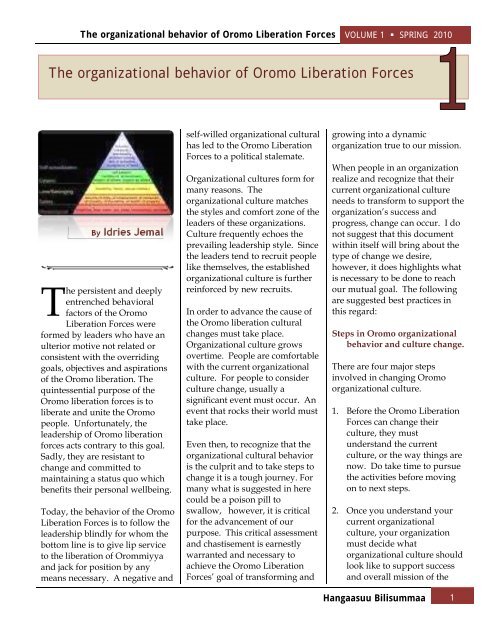Hangaasuu Bilisummaa Journal Volume 1 - ULFO
Hangaasuu Bilisummaa Journal Volume 1 - ULFO
Hangaasuu Bilisummaa Journal Volume 1 - ULFO
You also want an ePaper? Increase the reach of your titles
YUMPU automatically turns print PDFs into web optimized ePapers that Google loves.
The organizational behavior of Oromo Liberation Forces VOLUME 1 SPRING 2010<br />
The organizational behavior of Oromo Liberation Forces<br />
The organizational behavior of Oromo Liberation Forces<br />
By Idries Jemal<br />
The persistent and deeply<br />
entrenched behavioral<br />
factors of the Oromo<br />
Liberation Forces were<br />
formed by leaders who have an<br />
ulterior motive not related or<br />
consistent with the overriding<br />
goals, objectives and aspirations<br />
of the Oromo liberation. The<br />
quintessential purpose of the<br />
Oromo liberation forces is to<br />
liberate and unite the Oromo<br />
people. Unfortunately, the<br />
leadership of Oromo liberation<br />
forces acts contrary to this goal.<br />
Sadly, they are resistant to<br />
change and committed to<br />
maintaining a status quo which<br />
benefits their personal wellbeing.<br />
Today, the behavior of the Oromo<br />
Liberation Forces is to follow the<br />
leadership blindly for whom the<br />
bottom line is to give lip service<br />
to the liberation of Orommiyya<br />
and jack for position by any<br />
means necessary. A negative and<br />
self-willed organizational cultural<br />
has led to the Oromo Liberation<br />
Forces to a political stalemate.<br />
Organizational cultures form for<br />
many reasons. The<br />
organizational culture matches<br />
the styles and comfort zone of the<br />
leaders of these organizations.<br />
Culture frequently echoes the<br />
prevailing leadership style. Since<br />
the leaders tend to recruit people<br />
like themselves, the established<br />
organizational culture is further<br />
reinforced by new recruits.<br />
In order to advance the cause of<br />
the Oromo liberation cultural<br />
changes must take place.<br />
Organizational culture grows<br />
overtime. People are comfortable<br />
with the current organizational<br />
culture. For people to consider<br />
culture change, usually a<br />
significant event must occur. An<br />
event that rocks their world must<br />
take place.<br />
Even then, to recognize that the<br />
organizational cultural behavior<br />
is the culprit and to take steps to<br />
change it is a tough journey. For<br />
many what is suggested in here<br />
could be a poison pill to<br />
swallow, however, it is critical<br />
for the advancement of our<br />
purpose. This critical assessment<br />
and chastisement is earnestly<br />
warranted and necessary to<br />
achieve the Oromo Liberation<br />
Forces’ goal of transforming and<br />
growing into a dynamic<br />
organization true to our mission.<br />
When people in an organization<br />
realize and recognize that their<br />
current organizational culture<br />
needs to transform to support the<br />
organization’s success and<br />
progress, change can occur. I do<br />
not suggest that this document<br />
within itself will bring about the<br />
type of change we desire,<br />
however, it does highlights what<br />
is necessary to be done to reach<br />
our mutual goal. The following<br />
are suggested best practices in<br />
this regard:<br />
Steps in Oromo organizational<br />
behavior and culture change.<br />
There are four major steps<br />
involved in changing Oromo<br />
organizational culture.<br />
1. Before the Oromo Liberation<br />
Forces can change their<br />
culture, they must<br />
understand the current<br />
culture, or the way things are<br />
now. Do take time to pursue<br />
the activities before moving<br />
on to next steps.<br />
2. Once you understand your<br />
current organizational<br />
culture, your organization<br />
must decide what<br />
organizational culture should<br />
look like to support success<br />
and overall mission of the<br />
<strong>Hangaasuu</strong> <strong>Bilisummaa</strong> 1


